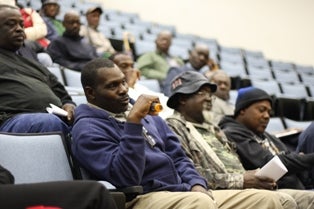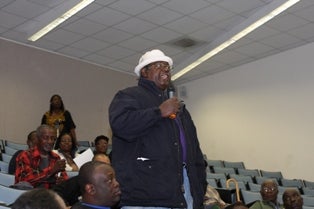 The Oceans program has developed robust relationships with an array of people across the U.S. including fishermen, scientists, academics, and political leaders; however, it‘s not every day that it works closely with royalty. Over the past several weeks, the Oceans program has partnered with Queen Quet, Chieftess of the Gullah/Geechee nation, and the organization she founded, the Gullah/Geechee Sea Island Coalition in its effort to engage African-American fishermen in the Southeast – the voices of whom haven’t been apart of the conversation to sustain fisheries.
The Oceans program has developed robust relationships with an array of people across the U.S. including fishermen, scientists, academics, and political leaders; however, it‘s not every day that it works closely with royalty. Over the past several weeks, the Oceans program has partnered with Queen Quet, Chieftess of the Gullah/Geechee nation, and the organization she founded, the Gullah/Geechee Sea Island Coalition in its effort to engage African-American fishermen in the Southeast – the voices of whom haven’t been apart of the conversation to sustain fisheries.
For many years, Queen Quet has diligently championed the conservation of the rich Gullah/Geechee culture and heritage. The Gullah/Geechee is a minority group within the African-American population. Spanning from the coast of Jacksonville, North Carolina to Jacksonville, Florida, the Gullah/Geechee nation has upheld the linguistics and traditions of their West African ancestry. The Gullah/Geechee are a people that have lived off the land and water for over 300 years, and their inherent ties to these resources are pervasive throughout their way of life.
 Because the continuity of this way of life is pertinent for Queen Quet and her people who have fished for generations, she expressed a keen interest in collaborating with EDF to better understand the challenges facing African-Americans for what has been perceived as a changing rate of participation in subsistence and commercial fisheries. To best document the concerns of this community, EDF and the Gullah/Geechee Sea Island Coalition cosponsored a listening session in Beaufort, South Carolina on January 21st. The event was a great achievement and brought together local and state officials and approximately 30 fishermen. For a group that generally has not been present at public forums in the past, this turnout signified the importance of the subject.
Because the continuity of this way of life is pertinent for Queen Quet and her people who have fished for generations, she expressed a keen interest in collaborating with EDF to better understand the challenges facing African-Americans for what has been perceived as a changing rate of participation in subsistence and commercial fisheries. To best document the concerns of this community, EDF and the Gullah/Geechee Sea Island Coalition cosponsored a listening session in Beaufort, South Carolina on January 21st. The event was a great achievement and brought together local and state officials and approximately 30 fishermen. For a group that generally has not been present at public forums in the past, this turnout signified the importance of the subject.
 According to Queen Quet, seafood is one of the major sources of employment for the Gullah/Geechee. During the meeting, the fishermen openly shared their concerns about the fishing industry, drawing comments from nearly everyone in the auditorium throughout the night.
According to Queen Quet, seafood is one of the major sources of employment for the Gullah/Geechee. During the meeting, the fishermen openly shared their concerns about the fishing industry, drawing comments from nearly everyone in the auditorium throughout the night.
The adversities identified by the community included size and catch limit restrictions, limited access to docks and oyster beds, depletion of fish stocks, unawareness of changing regulations and management decisions, and rising costs. These are the type of issues confronted by many of the fishermen with whom EDF works. Although the fishermen looked to EDF to present solutions to the issues identified, they also saw the value in shaping a collective voice. When asked, there was an incredible consensus by the fishermen to form a Black fishermen association encompassing the South Atlantic region.
The information gathered from these sessions will be shared with political leaders such as Jim Clyburn (D-SC) and members of the Congressional Black Caucus to bring awareness to an issue affecting the livelihoods of their constituency and begin to chart a way forward. We intend to proceed with another listening session in North Carolina in April.
As the session concluded, the attendees were interested in keeping this momentum strong and inquired about a follow-up meeting taking place. Needless to say, we were extremely heartened about this great start. We will work to continue to build a strong relationship with this community and help them find solutions to their challenges that will result in sustainable and healthy fisheries.
Nicole Smith is a 2009 – 2010 Oceans Program Fellow working to engage African-American fishermen in the U.S. southeast.










 The recent U.N. Climate Change conference in Copenhagen highlighted the range of challenges associated with fighting climate change, from cutting energy use to financing clean technology in developing countries. Why the global sense of urgency and focus? Because the impacts of climate change are already being felt. Most of our discussions center on the dangers of sea level rise, which is already inundating low-lying islands and valuable wetlands; on changes in precipitation and air temperature, which will affect everything from agriculture to asthma; and on the shift in seasons and habitat that will make life difficult for trees, butterflies, and the other wildlife we are familiar with.
The recent U.N. Climate Change conference in Copenhagen highlighted the range of challenges associated with fighting climate change, from cutting energy use to financing clean technology in developing countries. Why the global sense of urgency and focus? Because the impacts of climate change are already being felt. Most of our discussions center on the dangers of sea level rise, which is already inundating low-lying islands and valuable wetlands; on changes in precipitation and air temperature, which will affect everything from agriculture to asthma; and on the shift in seasons and habitat that will make life difficult for trees, butterflies, and the other wildlife we are familiar with.
![Loggerhead close up over aqua_2792097[1]_shutterstock_RF Loggerhead close up over aqua_2792097[1]_shutterstock_RF](https://blogs.edf.org/edfish/wp-content/blogs.dir/18/files/2010/01/Loggerhead-close-up-over-aqua_27920971_shutterstock_RF-300x186.jpg) The
The  Kate, what do you do at EDF?
Kate, what do you do at EDF?